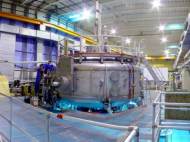Taming nuclear fusion – Levitated Dipole Experiment (LDX)
 Fusion has been a cherished goal of physicists and energy researchers for more than 50 years, since it offers the possibility of nearly endless supplies of energy with no carbon emissions and far less radioactive waste than that produced by today’s nuclear plants. A new experiment that reproduces the magnetic fields of the Earth and other planets has yielded its first significant results. The findings confirm that the approach has some potential to be developed as a new way of creating a power-producing plant based on nuclear fusion — the process that generates energy in the way the Sun does.
Fusion has been a cherished goal of physicists and energy researchers for more than 50 years, since it offers the possibility of nearly endless supplies of energy with no carbon emissions and far less radioactive waste than that produced by today’s nuclear plants. A new experiment that reproduces the magnetic fields of the Earth and other planets has yielded its first significant results. The findings confirm that the approach has some potential to be developed as a new way of creating a power-producing plant based on nuclear fusion — the process that generates energy in the way the Sun does.
The new results come from an experimental fusion reactor at the Plasma Science and Fusion Center on the MIT campus, inspired by observations from space made by satellites. Called the Levitated Dipole Experiment (LDX), a joint project of MIT and Columbia University, it uses a half-ton donut-shaped magnet about the size and shape of a large truck tire, made of superconducting wire coiled inside a stainless steel vessel. This magnet is suspended by a powerful electromagnetic field, and is used to control the motion of the 10-million-degree-hot electrically charged gas, or plasma, contained within its 4.9m diameter (16 feet diameter) outer chamber.
Levitation is crucial because the magnetic field used to confine the plasma would be disturbed by any objects in its way, such as any supports used to hold the magnet in place. In the experimental runs, they recreated the same conditions with and without the support system in place, and confirmed that the confinement of the plasma was dramatically increased in the levitated mode, with the supports removed. With the magnet levitated, the central peak of plasma density developed within a few hundredths of a second, and closely resembled those observed in planetary magnetospheres (such as the magnetic fields surrounding Earth and Jupiter).
When operating, the huge LDX magnet is supported by the magnetic field from an electromagnet overhead, which is controlled continuously by a computer based on precision monitoring of its position using eight laser beams and detectors. The position of the half-ton magnet, which carries a current of one million amperes (compared to a typical home’s total capacity of 200 amperes) can be maintained this way to within half a millimeter. A cone-shaped support with springs is positioned under the magnet to catch it safely if anything goes wrong with the control system.
Most experiments in fusion around the world use one of two methods: tokamaks, which use a collection of coiled magnets surrounding a donut-shaped chamber to confine the plasma, or inertial fusion, using high-powered lasers to blast a tiny pellet of fuel at the device’s center. But LDX takes a different approach. “It’s the first experiment of its kind,” says MIT senior scientist Jay Kesner, MIT’s physics research group leader for LDX, who co-directs the project with Michael E. Mauel, professor of applied physics at Columbia University’s Fu Foundation School of Engineering and Applied Science.
Kesner cautions that the kind of fuel cycle planned for other types of fusion reactors such as tokamaks, which use a mixture of two forms of “heavy” hydrogen called deuterium and tritium, should be easier to achieve and will likely be the first to go into operation. The deuterium-deuterium fusion planned for devices based on the LDX design, if they ever become practical, would likely make this “a second-generation approach,” he says.
The results confirm the counter-intuitive prediction that inside the device’s magnetic chamber, random turbulence causes the plasma to become more densely concentrated — a crucial step to getting atoms to fuse together — instead of becoming more spread out, as usually happens with turbulence. This “turbulent pinching” of the plasma has been observed in the way plasmas in space interact with the Earth’s and Jupiter’s magnetic fields, but has never before been recreated in the laboratory.









Great article!
The future is looking brighter each day I read about Nuclear Fussion. Thank you to all the scientists and engineers who make this possible!